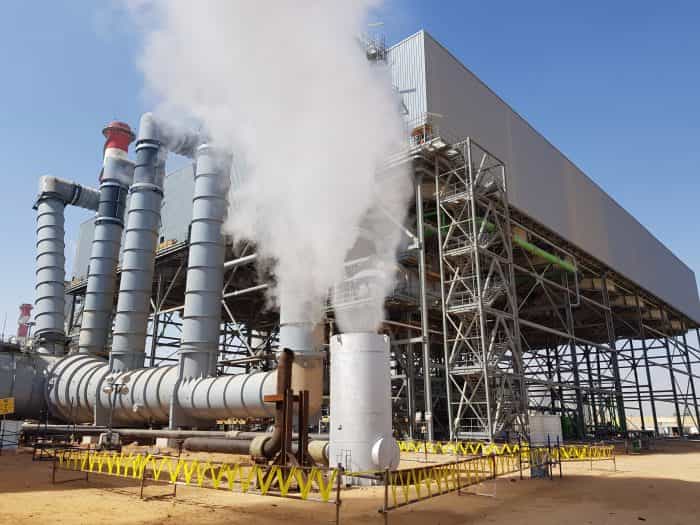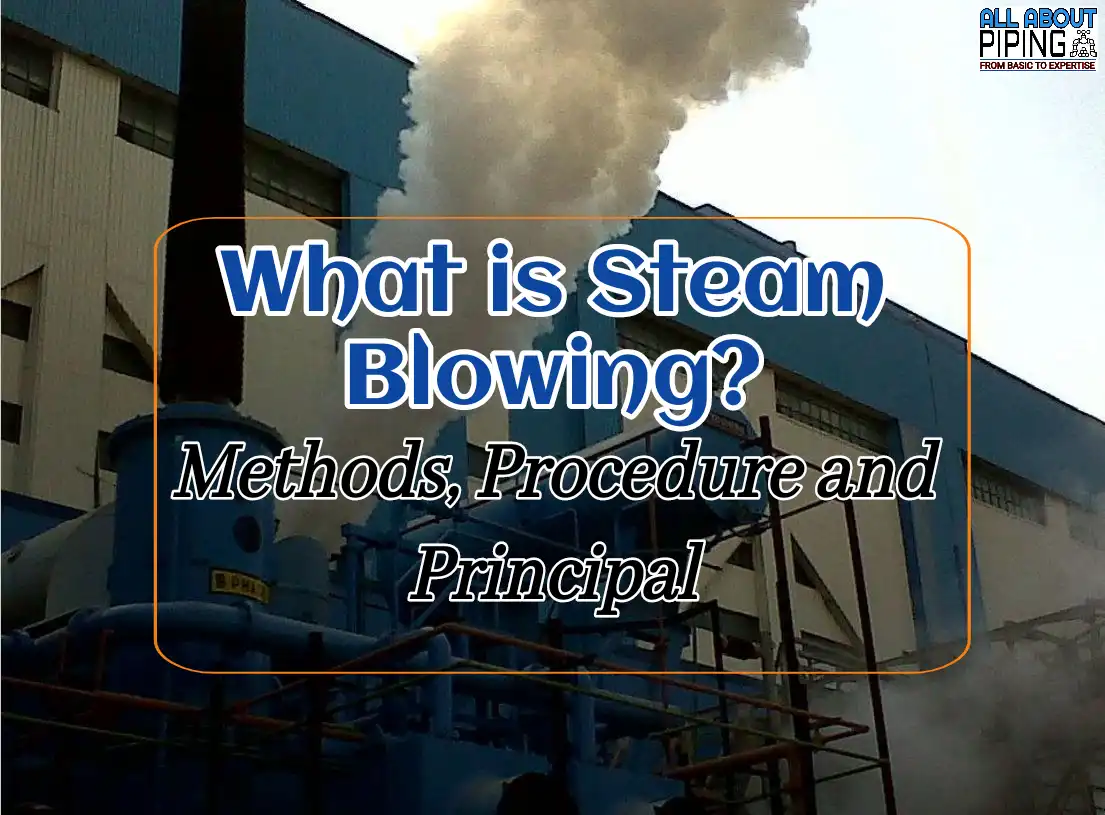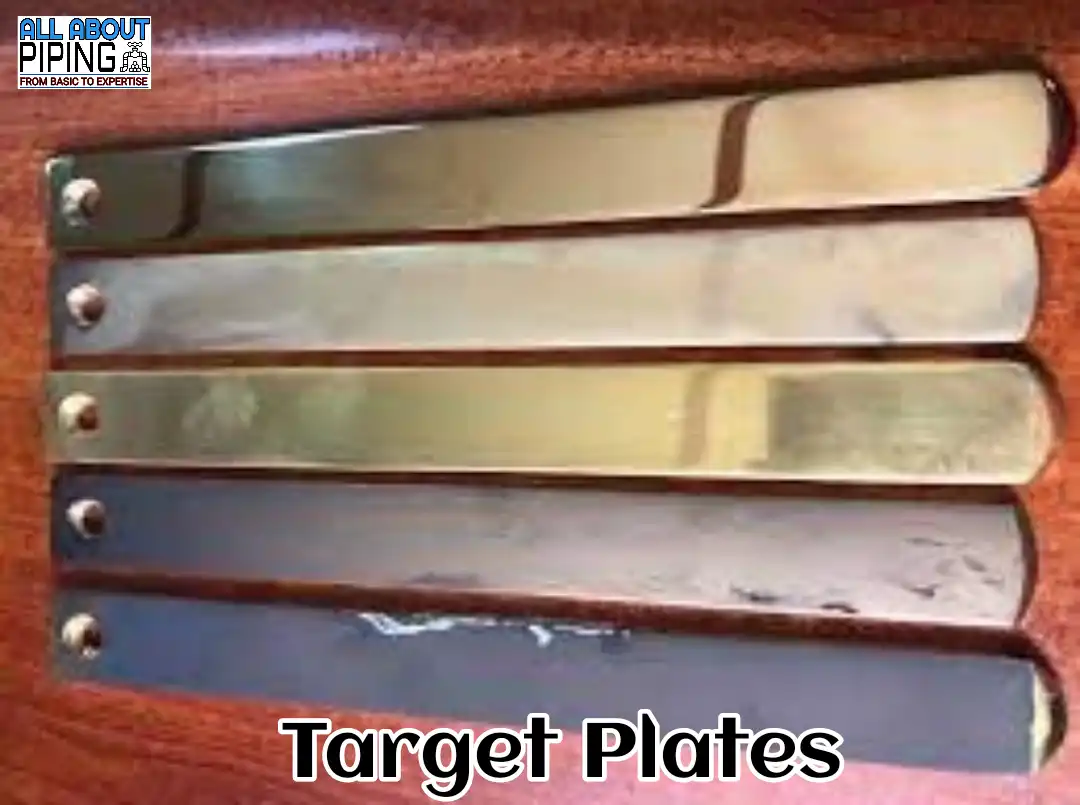Before commissioning, it is mandatory to clean the internal surface of pipes. To make it rust, dust, scales, and debris-free steam blowing is done. In case, this process is not done in a proper manner then connected critical components like a steam trap, the control valve can be damaged or its life span will reduce drastically.
Over time, Many enhancement has been made in plant start-up techniques to perform and improve steam blowing. During steam blowing the piping is blown with sufficient force of steam to ensure dynamic pressure in the pipe for adequate cleaning.
In this article on “Steam blowing” you will learn the following in detail:
- What is steam blowing and why it is used?
- Different methods of steam blowing
- Procedure of pre-cleaning and steam blowing method.
- Nosie reduction method during steam blowing.
- Calculation for required force of steam during cleaning.
Featured Article: What is Piping Isometric drawing? How to Read Piping Isometric Drawing?
Table of Contents
What is Steam blowing?
Steam blowing is a method of cleaning of piping system where the energy and speed of steam are used to remove the impurities from the piping network. The temperature difference during steam blowing is used to remove the mill scale due to the expansion and contraction of the pipe.
The steam blowing method is similar to the Pressurised Air blowing technique but in this case, a boiler is fired to generate the pressurized steam used for cleaning pipes. Some specialized quick opening valves with a detailed procedure in parallel with a properly designed temporary network, steam quenching devices, silencers, and debris-containing equipment are used to perform this operation.
Terms Related to steam Blowing
- CRH Line: Cold Re-heat, is the steam that lost its heat and pressure that can create an impact during steam blowing procedure. This direct steam towards inlet of steam generator.
- HRH Line: Hot Re-heat, is the reduced pressure steam that is diverted towards condenser.
- SH: Superheater
- RH : Re-heater
- HP: High pressure
- LP: Low pressure
- CFR: Cleaning force ratio
- MCR: Maximum continuous rating, is the capability of steam boiler/Generator to produce and provide the required quantity of steam continuously and easily without any unwanted effects.
- PRDS: Pressure Reducing and DeSuperheating System, is used for Steam Conditioning Services for reduction of pressure and temperature of steam.
- Puffing: It is a process to give a thermal shock to the internal surface of pipe being purged, to dislodge the scale.
More Resources: Types of Steam Trap: Working, Advantage, Disadvantage
Why Steam blowing is required?
When pipe fabrication was under progress during hot working days, an oxide layer is formed on the inside surface of pipes. This layer is known as mill scale and this must remove from the system before charging the line with the service.
Cleaning by steam blowing is carried essentially for steam piping networks. Due to the problem of condensation of steam or draining of condensate. During the start-up of any plant, there is a possibility the particles left in the pipe from the construction stage could break and travel downstream. These particles can damage instrumentation and other critical components of the piping network.
In general, Boiler pressure used in steam blowing gives a dynamic pressure throughout the piping that is at least 20% higher than normal operating conditions. Any potential damaging particle remaining inside the pipe can blow out the piping system during plant operation.
Methods of Steam blowing
There are 02 effective ways through which we can perform steam blowing for internal cleaning of pipes:
- High pressure cyclic steam blowing
- Low pressure countinuous steam blowing
Details of each Method of steam blowing are described in the following sections.
High Pressure Cyclic steam blowing
In this method of steam blowing, the Piping arrangement for steam blowing is gradually pressurized until a predetermined pressure is reached. Once the required pressure is developed in the steam blowing system, the Valve connected to it is being opened quickly to release steam.
A quick opening of pressurized contained steam in the piping system that needs to clean develops a transonic phase with a high mass flow rate. In order to employ the cyclic blow, temporary piping has to be properly designed, and stress analysis to be done before starting.
This method is repeated at regular intervals with the same steam pressure and mass flow rate until the cleanliness of the piping system is not determined. Normally, no more than one cycle can be performed daily to ensure adequate cooling of the piping system.
Advantage of discountinuous steam blowing
- Because of higher pressure and temperature in this method there is more thermal expansion in the main piping system.
- No gradients to large diameter required from the steam blowing line to silencer.
- No extra process or drinking water injection system required.
Disadvantage of discountinuous steam blowing
- Required K-factor is achived but it is for very short period.
- Load increases greatly due to rapid increase and decrease in pressure and temperature.
- Steam blowing is performed is not as per design parameter of the system.
- Large amount of DM water required compared to countinuous steam blowing.
- Temporary steam blowing system attaracts more cost as it need to be made of alloy steam.
- Temporary blow out valve required which is addition in cost.
- Steam generator need to restart before sucsseding cycles can be started.
Low Pressure countinuous steam blowing
During the pre-commissioning process, it is standard practice to continuously feed low-pressure steam for cleaning most steam piping systems. This method of steam blowing requires steam generators that continuously generate and fire steam.
In this case, the velocity developed by the steam generator is higher than the velocity of steam during normal plant operation. To control the pre-determined and required velocity of steam an orifice plate is installed at the inlet of the piping system, The steam with low pressure continuously blows until a satisfactory level of cleaning is achieved.
Recommended Parameter for Continuous steam blowing
A typical most efficient conditional parameter for continuous steam blowing are:
- Dynamic steam pressure = 3.5 MPa
- MS temp = 420°C (not to exceed)
- HRH (Hot Re-heat) Line temp = 480°C ( not to exceed)
- Steam flow = 845 TPH (Tonn per hour)
- Corresponding Drum pr. = 40 Ksc (Kg force/cm2)
- Furnace load ≈ 39%
Advantage of Low-pressure continuous steam blowing
- The required K-factor is achived for a longer period of time during steam blowing cycles.
- Lower load on the system due to gradual and uniform increase in pressure and temperature.
- Steam blowing is done within design parameters.
- Smaller amount of DM water required compared to discountinuous method.
- Temporary steam blowing piping system can be made of CS pipe which is cheaper.
- No temporary blow out valve required.
Disadvantage of Low pressure continuous steam blowing
- Larger diameter of temporary piping required from steam blow line to the water injection system.
- Extra process or drinking water required for water injection system compared to discountinuous method.
- Larger and gradients to larger diameters of temporary piping required from the steam blow line to the water injection system;
- Extra process/drinking water required for water injection system compared to discontinuous method.
Puffing vs Continuous method of steam blowing
| Puffing Method | Continuous Method |
|---|---|
| More time is required for complete steam blowing due to stage-wise blowing(8-10 days) | Less time required for completion (3-4 days) |
| More time is required for stage wise temporary pipe erection and shifting of blowing device | Less time required as only valves to be opened for different systems |
| No mill required | Minimum 02 nos. of mill required |
| Quality of cleanliness is better than a continuous process | The quality of cleanliness is slightly less than Puffing. |
| Thermal shock is the driving force of cleaning | Steam velocity or Removal force is the driving force |
| More thermal stress on tube material and sudden loading on supports | Less thermal stress on tube material |
| Repeated light-up and shutdown | Light-up only once at the beginning of the steam blowing |
| There is a time gap between the blows to make up DM water | DM water make-up to the system during steam blowing is a challenge |
| System normalization time after steam blowing is more | System normalization time after steam blowing is less. |
| Use of Silencer is optional | Silencer use is compulsory to reduce the noise level |
More Resources: Heat Tracing in Piping: Types, Working, Use, Installation, Comparison (Steam Tracing vs Electrical Tracing)
Principle of Steam blowing
During steam blowing, the Piping network should be blown with enough velocity of steam to ensure sufficient cleaning force for the removal of debris, rust, and scale. Typically during the steam blow, the force of steam should be at least 20% higher than it would be during normal operating conditions
Thus the cleaning force required for steam blow should be ≥ 1.2, (i.e. CFR ≥ 1.2). This much force is required so that any potential damaging particle will be blown out of the piping system before the commissioning and plant operation.
Steam blowing flow calculation formula
The force required for cleaning purposes by steam blow is calculated with help of formula:
Here,
- CFR: Cleaning Force required
- Qc: Mass flow rate of steam required for cleaning
- Qo: Mass flow rate of steam during normal operation
- Vc: Specific volume of steam during cleaning
- Vo: Spcific volume of steam during normal operation
Pre-cleaning Procedure for steam blowing
There are some checkpoints that need to attain before proceeding with steam blowing. The pre-cleaning procedure for steam blowing are as follows:
- Check for all piping supports mainly guides and Anchor including teporary support for steam blowing system arrangement.
- Ensure about all line have been inspected properly and hydrotested.
- CHeck for removal of all control valve, desuperheater, flow measuring components, thermowell and any other critical piping components attached to piping system.
- Check for adequet drain in temporary steam blowing piping system.
- Check if these drains are routed to a safe location.
- Install temporary pressure gauge to monitor pressure developed in the system and record pressure readings.
- Establish a proper communication medium between controling point and operator at shutoff valve. Also check for visual communication establishment, such as light, flags in case audio communication is not so audible in high level noise.
- Ensure about restricted movement of workers during steam blowing.
- Check for area near to steam blowing vent pipe is clear of all person during steam blowing
- Proper wearables must to use for protection of ears from high noise levels.
Steam Blowing Procedure
After preparation of all points in the pre-cleaning procedure for steam blowing. The actual process of steam blowing starts with the permission of deciding authority in the control room. Steam bowing procedures to be followed are:
- Start the steam generator and boiler pressure need to slowly increase upto a required level and firing rate.
- The first blow need to performed at low pressure to check stablity of temporary supports and permanent supports of complete system.
- Temporary valve opening to be done to blow steam through superheater, main steam pipe and temporary pipes too.
- First few steam blowing need to perform with targate plate untill steam colour appered to be clear.
- After getting a clear steam, target plates need to place to capture particle going with the steam from main piping network.
- While blowing fire is to put out and pressure is dropped to ensure proper temperature differential to dislodge any material.
- Steam blowing need to close and boiler is started again for pressure build-up.
- Cleaning to be checked time to time untill a satisfactory level of cleaning is achived.
- After a achievement of required cleanliness standard stop the steam generator and close steam blowing valve after all pressure build-up in generator reaches to zero value.
- After mainstream line is cleaned with steam blowing all other network need to clean in similar manner.
Noise reduction during steam blowing

The release of steam from the steam generator to the atmosphere creates too high noise with fog around it. This much sound can disturb activities running nearby. To reduce the noise level up to some acceptable steam must be cooled by condensate.
In general, there are two methods to reduce noise:
- First one, is to install a traditional silencer that works like an expander. This increases the surface area and helps to cool down the steam. This noise reduction method is used for high pressure discountinuous steam blowing.
- The Second type, Works by means of water injection system, i.e. quenching. In this method steam losses it heat and condenses. the condensate than partially collected for reuse during steam blowing. This method of noise reduction is used for low pressure countinuos steam blowing.
How to determine cleanliness after steam blowing?
Checking and determination of cleanliness of piping system after steam blowing is tested with “Targeted plates”. These plates are made of Aluminium or Copper. It is determined with 03 steps as follows:
- Targate plate need to place at the outlet point of main piping system during steam blowing. And impact on the Targate plate to be checked during steam blowing.
- Cleaning through steam blowing can be considered when 02 consecutive targate plate results with less than 02 pits per square inch with maximum diameter of 0.3mm.
- When steam blowing is completed, steam traps and other equipment that were removed prior to steam blowing need to reinstall.
After all 03 steps piping system can reheat and charge with service as per the operational purpose.
Target plate Selection Criteria
Some criteria for selection of Targeted plate for checking of cleanliness during steam blowing are as follows:
- Dimensions of targate, Widthshould be 8% of Steam vent inner diameter and Length should be equal to ID.
- Brinell hardness number should be Less than 90.
- No indentation exceeding 0.8 mm diameter
- Indentations exceeding 0.4 mm diameter to number not more than 2 per 1000 mm2 of the target plate surface.
- Indentations exceeding 0.2 mm to number not more than 10 per 1000 mm2 of the target plate surface.
- Indentations less than 0.2 mm to be well dispersed with low concentration and or nowhere present on concentration.
Conclusion
Steam blowing is a forced cleaning procedure to internal surface cleaning of the piping network. Steam blowing is done for the removal of debris, welding grits, or scales on the internal surface of the pipe. In short, this article can be summarised in following points:
- It save critical component installed in piping network from getting damaged from unwanted particles.
- There are 02 method of steam blowing:
- High pressure cyclic steam blowing or Puffing
- Low pressure countinuous steam blowing
- There is too much noise produced during countinuous steam blowing. So, it is necessary to install silencer for noise level reduction.
- During steam blow, force steam applied should be 20% higher than force of steam at normal operating condition.
- Before steam blowing there are some check point that need to follow as discussed in earlier paragraphs.
- To determine if Piping network is clean or not a “Targate plate” made of either aluminium or copper is positioned at outlet point of steam. If 02 consecutive targate plates have 02 grits/Inch2 than it is cleaning is within accepteable limit.



